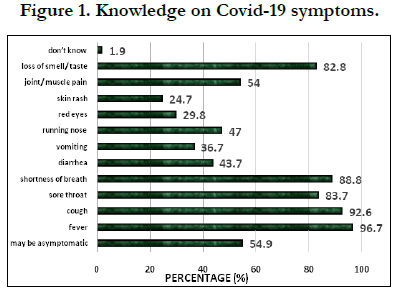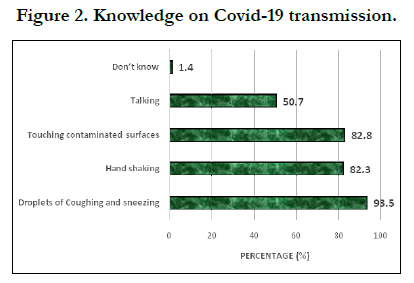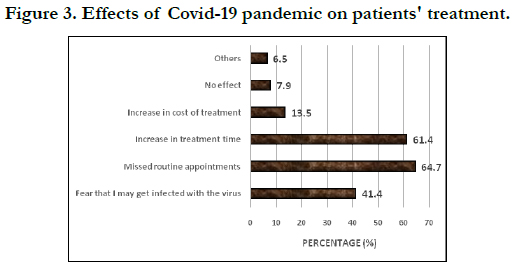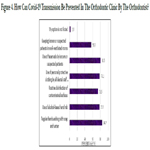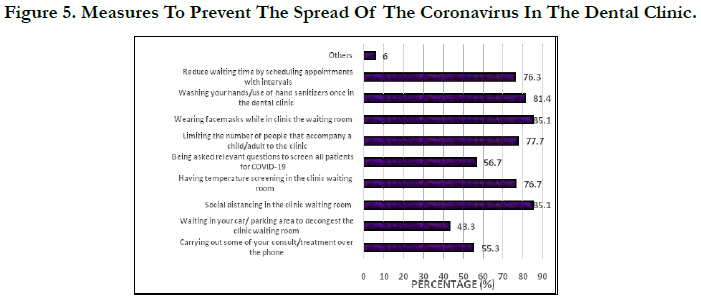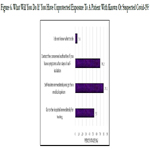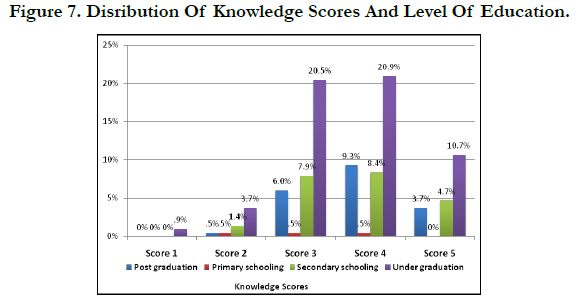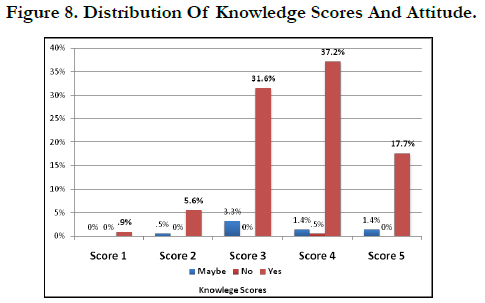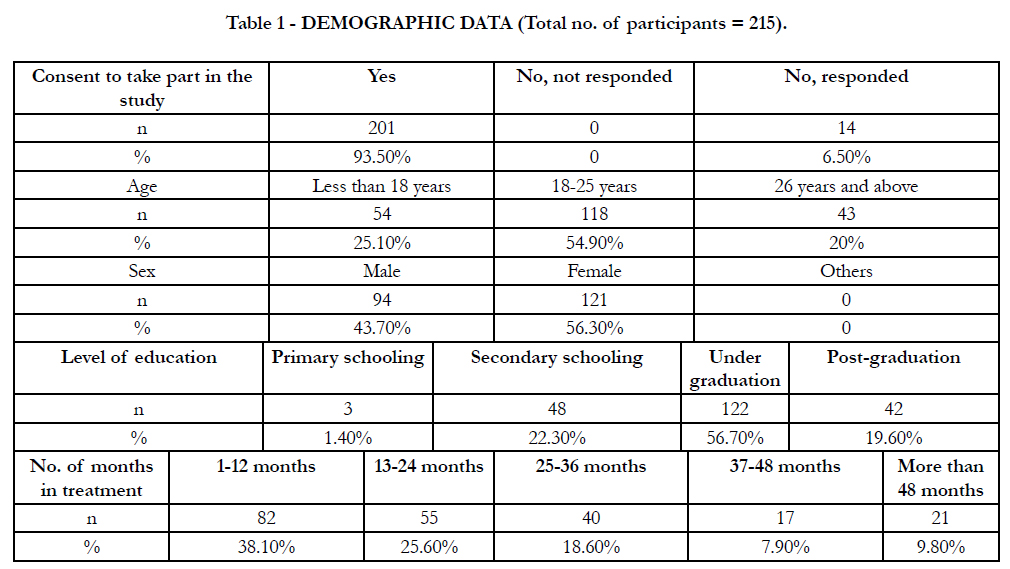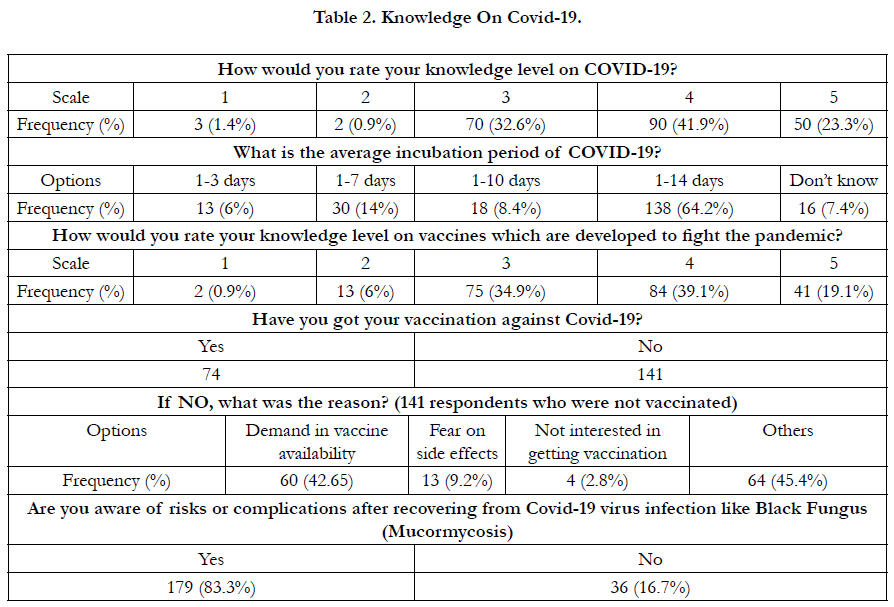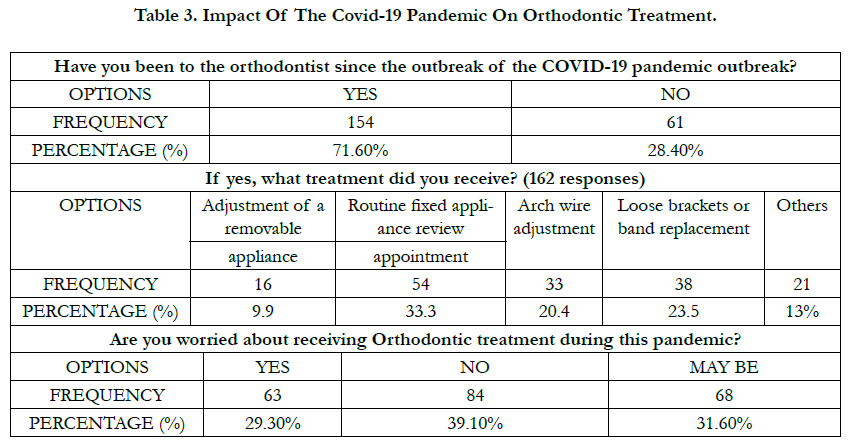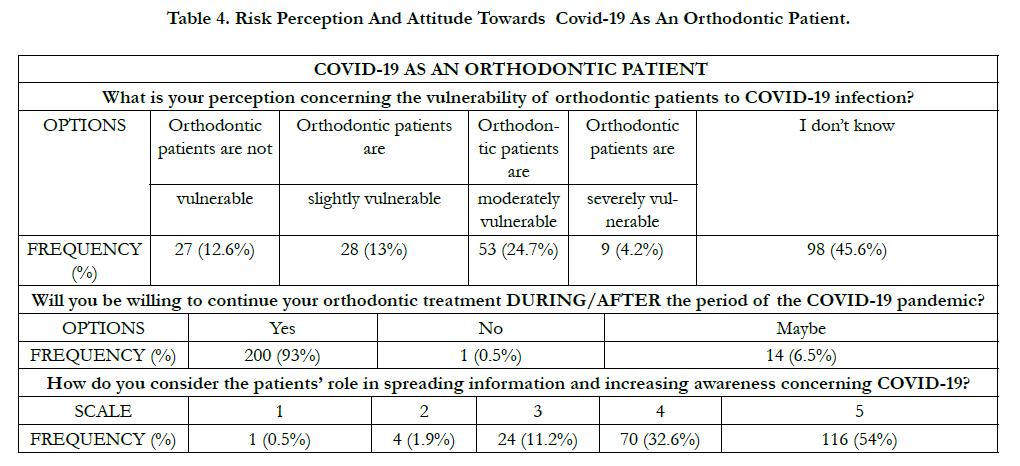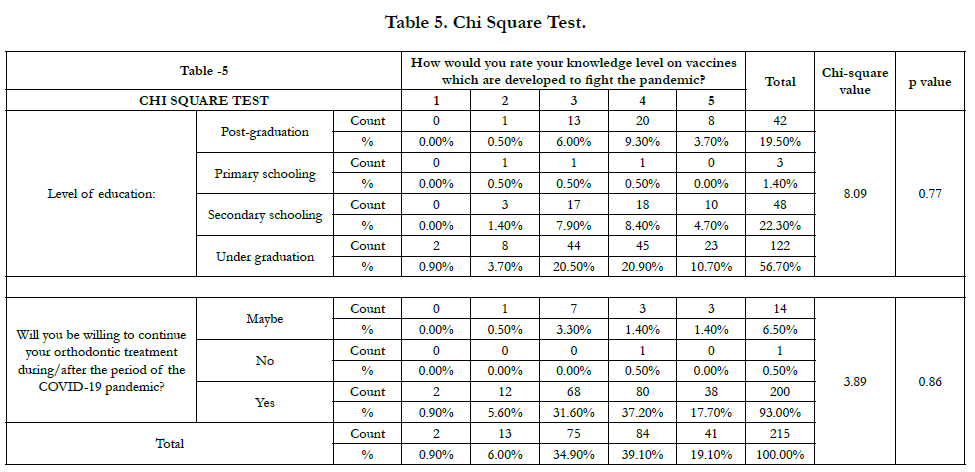Orthodontic Treatment During Covid-19 Pandemic – A Cross Sectional Study On Patients’ Perspective And Attitude
Sunil Kumar M1, Ashok Kumar2*, Padmanathan R3
1 Professor, Department of Orthodontics and Dentofacial Orthopedics, Faculty of Dental Sciences, Ramaiah University of Applied Sciences, Banglore- 54, India.
2 Post Graduate, Department of Orthodontics and Dentofacial Orthopedics, Faculty of Dental Sciences, Ramaiah University of Applied Sciences, Banglore-54 India.
3 Post Graduate, Department of Orthodontics and Dentofacial Orthopedics, Faculty of Dental Sciences, Ramaiah University of Applied Sciences, Banglore-54, India.
*Corresponding Author
Dr. Ashok Kumar M D,
Post Graduate, Department of Orthodontics and Dentofacial Orthopedics, Faculty of Dental Sciences, Ramaiah University of Applied Sciences, Banglore-54 India.
Tel: 9943168569
E-mail: ashokmd5597@gmail.com
Received: September 21, 2021; Accepted: October 28, 2021; Published: October 29, 2021
Citation:Sunil Kumar M, Ashok Kumar, Padmanathan R. Orthodontic Treatment During Covid-19 Pandemic – A Cross Sectional Study On Patients’ Perspective And Attitude.
Int J Dentistry Oral Sci. 2021;8(10):4857-4863. doi: dx.doi.org/10.19070/2377-8075-21000982
Copyright: Ashok Kumar M D©2021. This is an open-access article distributed under the terms of the Creative Commons Attribution License, which permits unrestricted use, distribution and reproduction in any medium, provided the original author and source are credited.
Abstract
Background: During this pandemic outbreak the protocols followed in all countries became a barrier to the existing dental
practice. According to literature, this pandemic had a severe negative impact on orthodontic care provided to patients. There is
less literature on the patient perspectives, who are undergoing orthodontic treatment. In India, the first wave of this pandemic
outbreak which came to an end by the end of 2020, after which the second wave started in early 2021, and is ongoing. Orthodontists
cannot delay the treatment for ongoing cases for a long time.This cross sectional survey among patients undergoing
orthodontic treatment aims at assessing their knowledge about the ongoing pandemic, attitude on orthodontic treatment during
these difficult times and the precautions needed to be followed in an orthodontic practice.
Materials And Methods: The study was conducted as a cross-sectional survey among patients undergoing orthodontic treatment
in the dental hospital. The questionnaire was framed with reference from a study conducted by Umeh OD et al. The
questionnaire was pilot tested and was distributed as a self-assessed e-questionnaire to the patients via social media platforms.
Total of 215 responses obtained from the patients were compiled, processed further, and analyzed by entering the obtained
data in Microsoft Excel 2007 version and graphs were made to represent them. Further statistical analysis was done. Table-1
demonstrated the demographic data of the study participants.
Results: The knowledge levels on the Covid-19 disease were adequate and there was a significant impact on the treatment
which the participants were undergoing. When comparing these with the level of education, it was found to be insignificant.
Conclusion: Even if most of the patients were having issues on the undergoing treatment, they had a positive attitude in
continuing the treatment during/after the pandemic. Various awareness programs in all available platforms both for the orthodontist
and patients should be conducted to vigorously address this concern.
2.Introduction
3.Materials and Methods
3.Results
4.Discussion
5.Conclusion
5.References
Introduction
Coronavirus disease (COVID-19) is an infectious disease caused
by a newly discovered virus. On 31 December 2019, WHO was
informed of cases of pneumonia of unknown cause in Wuhan
City, China. A novel coronavirus was identified as the cause and
was temporarily named “2019-nCoV” after which it was declared
as a pandemic.[1-3]
The patients who suffered from this COVID 19 showed typical
symptoms such as fever, cough, fatigue with abnormal chest CT.
Sputum production, head ache, hemoptysis and diarrhea [4-6] was
also observed in some cases. The COVID-19 infectious agent is
affecting older male patients with critical respiratory diseases [7,
8] requiring special attention to older males. This coronavirus
(COVID-19) clinical symptoms were different from SARS corona
virus seen in 2002-2003. This human-to-human transmission of
virus has developed this Coronavirus (COVID-19) outbreak [8,
9]. The new virus genome was sequenced after quick isolation
in Chinese Wuhan’s laboratories [10]. This infectious agent was
finally identified as a novel corona virus (2019-nCOV). This is
the seventh member of family of corona virus which infects humans [11]. The international Committee on Taxonomy of Viruses
(ICTV) suggested the name “SARSCOV-2” for the new coronavirus
due to the polygenetic and taxonomic analysis [12]. This
novel viral pneumonia was finally named as “Corona Virus Disease
(COVID 19)” by WHO on 11th February 2020.
During this pandemic outbreak the protocols followed in all
countries became a barrier to the existing dental practice. According
to literature, this pandemic had a severe negative impact on
orthodontic care provided to patients. There is less literature on
the patient perspectives, who are undergoing orthodontic treatment.
In India, the first wave of this pandemic outbreak which
came to an end by the end of 2020, after which the second wave
started in early 2021, and is ongoing. Orthodontists cannot delay
the treatment for ongoing cases for a long time.
This cross sectional survey among patients undergoing orthodontic
treatment aims at assessing their knowledge about the ongoing
pandemic, attitude on orthodontic treatment during these
difficult times and the precautions needed to be followed in an
orthodontic practice.
Management Of Orthodontic Emergency Protocol
Professionals assess whether to stay open or to manage emergencies.
One can postpone the appointments based on single Nation’s
guidelines. Regarding any discomfort or problems relating
to appliances should be strictly followed by the patients. Repeated
breakages would prolong the treatment time and would end
up in loss of confidence in appliance or operator. It would also
decrease the patients’ motivation. Inconvenience, distress to patient
and parent can be minimized by maintaining the efficiency
of appliances, providing timely management. During COVID-19
pandemic guidelines issued by the Government should be strictly
followed. The dentists should see such cases which cannot be
postponed, such as an abscess or irreversible pulpitis. The urgent
cases other than general dentistry problems should be evaluated
by Orthodontists based on video call or message with photo.
Virtual assistance: WhatsApp Messenger (Facebook Inc, Mountain
view, California), are instant messaging applications developed
from 2009. They quickly spread among users of all ages.
They are used for personnel relationships, for entertainment, for
study and also as virtual place of contact in group. Orthodontic
emergencies should be attended step by step using new technology.
Virtual assistance and WhatsApp could be used in first step as
good tool. Photos, video calls, WhatsApp messages/calls are used
as virtual assistance. Ways of management of different emergencies
is explained in the table 2 below. [13, 14]
Materials And Methods
The study was conducted as a cross-sectional survey among patients
undergoing orthodontic treatment in the dental hospital
of Faculty of Dental Sciences, Ramaiah University of Applied
Sciences, Bangalore, India. The questionnaire was framed with
reference from a study conducted by Umeh OD et al [3]. he questionnaire
was pilot tested among orthodontic residents and post
graduates in the same University for its feasibility and validity and
was improvised based on their suggestions.
After testing, it was distributed as a self-assessed e-questionnaire
to the patients via social media platforms. The consent of the
participants was taken as a separate section in the questionnaire
form itself. Demographic data about the age, sex and level of
education was recorded under a separate section (Table-1). Patients
under the age of 15 were advised to seek parental guidance
to answer the questions. The questions were grouped and
categorized under three different sections. Total of 215 responses
obtained from the patients were compiled, processed further, and
analyzed by entering the obtained data in Microsoft Excel 2007
version and graphs were made to represent them. Various studies
were referred to gain more knowledge to improvise the study.
Further statistical analysis was done. Table-1 demonstrated the
demographic data of the study participants.
Statistical analysis
The minimum sample size of 215 was arrived by using the method
of estimation of sample size for population proportion with reference
to Umeh OD et al. with confidence value set at 0.95. SPSS
(Statistical Package for Social Sciences) version 20. (IBM SPASS
statistics [IBM corp. released 2011] will be used to perform the inferential
statistical analysis with the level of significance set at 5%.
Chi square test was conducted to compare the knowledge about
the vaccines developed for Covid 19 among various education
levels of the study participants (p=0.77) and also with the willingness
of the participants to continue the orthodontic treatment
during/after the pandemic (p=0.86). Tables and illustrations were
made using Microsoft Excel 2007 version to demonstrate the Chi
Square values.
Results
Table 2 demonstrates the knowledge of the participants on Covid-
19 disease. Figure 1,2 describes the responses of the participants
on symptoms and transmission of the Covid-19 disease.
Table 3 demonstrates the responses received on the impact of the
pandemic on orthodontic treatment. Figure 3 describes the effect
of this pandemic on the undergoing orthodontic treatment faced
by the participants.
Table 4 demonstrates the risk perception and attitude of the participants
towards Covid-19 disease as an orthodontic patient. Figure
4,5 throws light on the patients’ attitude on prevention of
exposure in an orthodontic clinic. Figure 6 explains the patients’
attitude on an unexpected exposure to a known or suspected
Covid-19 patient.
Table 5 and Figure 7,8 demonstrates the Chi Square Test, to compare
the knowledge levels on vaccines developed for Covid-19
disease and attitude of the patients on continuing orthodontic
treatment during/after the pandemic to the level of education
and was insignificant.
Figure 6. What Will You Do If You Have Unprotected Exposure To A Patient With Known Or Suspected Covid-19?
Discussion
The Covid-19 pandemic has a significant impact on orthodontic
treatment. Almost all orthodontic patients have to stop attending
the appointment at some point during the lockdown period, putting
them in a difficult situation and fear that their treatment will
be delayed. Most of the problems reported by patients receiving
treatment in public clinics and patients with fixed appliances. It
was concluded that there is a need to pay more attention to teleorthodontics,
especially during this period and in the foreseeable
future; in addition,if possible, orthodontists should prepare their
patients to treat problems related to their appliances.[1]
Most participants believe that dental office is the place with the
highest risk of spreading Covid-19, even if they will continue to
see the dentist. Due to Covid-19, gender, age, and pain level are
associated with increased fear of attending a dental clinic. Due to
the pandemic, 16% of the patients receiving orthodontic treatment
will not return to the dental clinic, while the rest will continue
orthodontic treatment after closure. Compared with the
patients who used removable appliances, the patients who used
fixed appliances felt more discomfort because they did not attend
their regular orthodontic appointments during the lockdown
period.[2]
We should make sure that before going to dental setups, people
should have all the related information about nCoV-19. Also, they should be aware of the cause, signs and symptoms, and
safety measures of nCoV-19 infection. The necessary seminars
and workshops should be arranged for the awareness of general
public regarding transmission of nCoV-19 and their respective
preventive measures. People should be asked to avoid unnecessary
visits to crowded areas and the medical health care and dental
setups. If only the visit is absolutely necessary, then use of masks
should be a must.
The procedures that include for an Orthodontist include use of high speed air turbine or slow speed rotary drill, 3 in 1 air/water
syringe, and enamel preparation using ultrasonic or air abrasion
devices. And these procedures could lead to direct impact on adhesive
removal from enamel, and the use of air/water sprays and
rotary handpieces for moisture control and cleaning. Also, with
the use of High Volume Suction (HVE) and/or rubber dam to
limit aerosol and the bio impact, these procedures are still considered
AGP and appropriate PPE should be worn, along with appropriate
decontamination protocols in the surgery. High and low
volume suction themselves are NOT considered AGP.
In our study, the knowledge levels on the Covid-19 disease were
adequate and there was a significant impact on the treatment
which the participants were undergoing. When comparing these
with the level of education, it was found to be insignificant. The
limitations of the study were that we did not include the socioeconomic
considerations and the sampling was randomized. This
gives a need for more studies to be conducted for assessing the
patients’ social, psychological difficulties in taking up an orthodontic
treatment during these times.
Conclusion
To conclude, awareness among the patients seems to be adequate.
Even if most of the patients were having issues on the undergoing
treatment, they had a positive attitude in continuing the treatment
during/after the pandemic. The orthodontist should be prepared
to continue the practice as per the guidelines issued by their nation. Various awareness programs in all available platforms both
for the orthodontist and patients should be conducted to vigorously
address this concern. Innovation and learning everyday can
pave way for a healthy future and can establish a preparedness if
any situations like these occur.
References
-
[1]. Bustati N, Rajeh N. The impact of COVID-19 pandemic on patients receiving
orthodontic treatment: An online questionnaire cross-sectional study.
Journal of the World federation of orthodontists. 2020 Dec 1;9(4):159-63.
[2]. Martina S, Amato A, Faccioni P, Iandolo A, Amato M, Rongo R. The perception of COVID-19 among Italian dental patients: an orthodontic point of view. Progress in Orthodontics. 2021 Dec;22(1):1-8.
[3]. Umeh OD, Utomi IL, Isiekwe IG, Aladenika ET. Impact of the coronavirus disease 2019 pandemic on orthodontic patients and their attitude to orthodontic treatment. American Journal of Orthodontics and Dentofacial Orthopedics. 2021 May 1;159(5):e399-409.
[4]. Huang C, Wang Y, Li X, Ren L, Zhao J, Hu Y, et al. Clinical features of patients infected with 2019 novel coronavirus in Wuhan, China. The lancet. 2020 Feb 15;395(10223):497-506.
[5]. Guan WJ, Ni ZY, Hu Y, Liang WH, Ou CQ, He JX, et al. Clinical characteristics of 2019 novel coronavirus infection in China. MedRxiv. 2020 Jan 1.
[6]. Wang D, Hu B, Hu C, Zhu F, Liu X, Zhang J, et al. Clinical characteristics of 138 hospitalized patients with 2019 novel coronavirus–infected pneumonia in Wuhan, China. Jama.2020; 323(11) :1061-1069.
[7]. Chen N, Zhou M, Dong X, Qu J, Gong F, Han Y, et al. Epidemiological and clinical characteristics of 99 cases of 2019 novel coronavirus pneumonia in Wuhan, China: a descriptive study. The lancet. 2020 Feb 15;395(10223):507-13.
[8]. Chan JF, Yuan S, Kok KH, To KK, Chu H, Yang J, et al. A familial cluster of pneumonia associated with the 2019 novel coronavirus indicating personto- person transmission: a study of a family cluster. The lancet. 2020 Feb 15;395(10223):514-23.
[9]. Li Q, Guan X, Wu P, Wang X, Zhou L, Tong Y, et al . Early transmission dynamics in Wuhan, China, of novel coronavirus–infected pneumonia. New England journal of medicine. 2020 Jan 29.
[10]. Wu F, Zhao S, Yu B, Chen YM, Wang W, Song ZG, Hu Y, Tao ZW, Tian JH, Pei YY, Yuan ML. A new coronavirus associated with human respiratory disease in China. Nature. 2020 Mar;579(7798):265-9.
[11]. Zhou P, Yang XL, Wang XG, Hu B, Zhang L, Zhang W, et al. A pneumonia outbreak associated with a new coronavirus of probable bat origin. nature. 2020 Mar;579(7798):270-3.
[12]. Gorbalenya AE, Baker SC, Baric R, Groot RJ, Drosten C, Gulyaeva AA, et al. Severe acute respiratory syndrome-related coronavirus: The species and its viruses–a statement of the Coronavirus Study Group.
[13]. Caprioglio A, Pizzetti GB, Zecca PA, Fastuca R, Maino G, Nanda R. Management of orthodontic emergencies during 2019-NCOV.
[14]. Popat H, Thomas K, Farnell DJ. Management of orthodontic emergencies in primary care–self-reported confidence of general dental practitioners. British dental journal. 2016 Jul;221(1):21-4.

